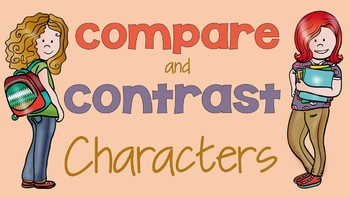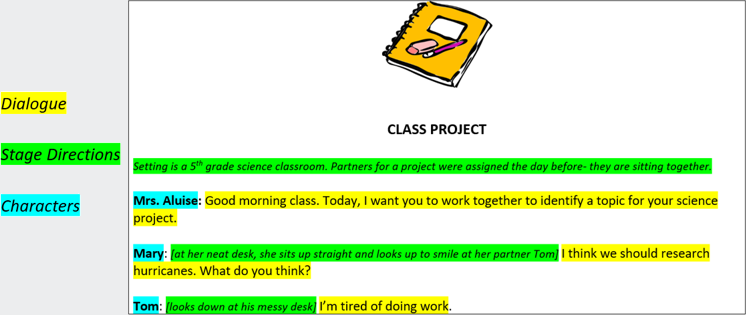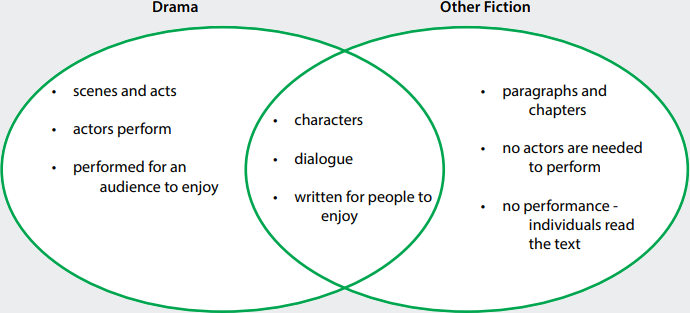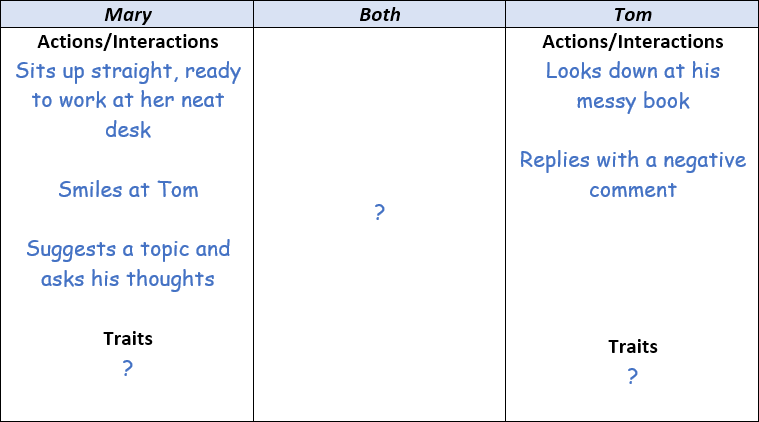Comparing and Contrasting Characters in
a Drama

In this unit you will learn how to compare
and contrast characters in a drama/play. Then, you will learn how to combine
sentences using conjunctions. Finally, you will continue reading the novel Shiloh
by Phyllis Reynolds Naylor.
· I can compare and contrast two or more characters
in a drama, drawing on specific details in the text. RL.5.3
|
Academic Talk Use these words and phrases to talk about the text. |
|
compare contrast drama stage directions dialogue |
When you compare and contrast what characters in a
drama do and say, you can better understand how they move the story along.
In a drama, or play, you can learn about characters by
reading or listening to the spoken dialogue between the characters. You can also read the stage directions,
which are short notes that tell what a character is doing on stage.

You can get to know characters better by comparing and contrasting them. Identify what the characters do and say to
each other, how they act, and how they look.
Skill Focus: Compare and Contrast
When you compare and contrast, you identify how two things are
alike and how they are different. For example: You can compare and contrast
dramas/plays to other works of fiction using a Venn Diagram.

You can compare and contrast characters in the same way.
Read
the passage below. As you do, think about the similarities and differences
between the characters.
Class Project Setting is a 5th grade science classroom.
Partners for a project were assigned the day before- they are sitting together. |
QUESTION: Consider
what you’ve learned about comparing and contrasting characters. How are Mary
and Tom similar and how are they different? What do they say and do? Look at
the chart below to compare and contrast the characters.
Hover
your cursor over the box to see if you correctly identified their character
traits and similarities.

QUESTION: Compare and contrast Mary and Tom in “Class Project.”
Be sure to incorporate transitions.
|
Transitions |
|
|
Connection |
Words and Phrases |
|
Comparison |
in the same way, likewise, similarly, both |
|
Contrast |
although, but, even so, on the other hand, however, nevertheless,
still, yet, in contrast to |
 |
Did you describe how the characters
are similar?
Did you describe how they are
different?
Did you support your response with
evidence from the text?
Did you use words transitions to
illustrate the comparison?
Let’s Practice!
Compare
Characters - Worksheet
Compare Characters - Answers
Independent Practice
Read the following informational article "Camping in the Cold" and then answer the questions.
Camping in the Cold PDF
Word Study
· I can use common, grade
appropriate Greek and Latin affixes and roots as clues to the meaning of a
word.
English
words come from many languages, including Greek and Latin.
A
root is a word part that usually can’t stand alone as a word. Sometimes
one root is added to another root to make a word. Affixes are word parts such
as prefixes and suffixes that are added to roots to make words. Knowing what affixes
and roots mean can help you figure out the meanings of words. As you learn
Greek and Latin roots and affixes, your vocabulary will grow.
During
the course of this class, you will be learning Greek and Latin roots, prefixes,
and suffixes- each unit a new one will be added to the chart below.
-able/-ible is a suffix that adds “can be done” onto a root. For
example: enjoyable. Enjoyable means “can be enjoyed.”
|
Prefix |
Suffix |
Root |
Meaning |
Examples |
Additional
Information |
|
semi- |
|
|
half |
semicircle, semicolon |
|
|
super- |
|
|
above/on top of/beyond |
superhuman, supersonic |
|
|
multi- |
|
|
many/much |
multicolor, multifamily |
|
|
poly- |
|
|
many/much |
polygon, polysyllable |
|
|
tele- |
|
|
distant/far |
television, telephone |
|
|
mis- |
|
|
bad or badly/wrong or wrongly |
misbehave, misread, misspell |
|
|
inter- |
|
|
between |
intercept, interview, interstate |
|
|
mid- |
|
|
middle |
midnight, midweek |
|
|
sub- |
|
|
under, beneath, below/secondary |
subway, subsoil, substitute |
|
|
deca- deci- |
|
|
ten |
decathlon, decade, decimal, decimeter |
|
|
milli- mille- |
|
|
1,000 |
millennium, millimeter |
|
|
kilo- |
|
|
1,000 |
kilogram, kilowatt |
|
|
centi- |
|
|
100 |
centimeter, centipede |
|
|
|
-ible
|
|
can be done |
enjoyable, sensible, likable |
-able ending words have roots that can stand
alone. enjoyable -ible ending words have roots that cannot
stand alone. sensible |
Language Lesson: Combining Sentences
· I can combine sentences for meaning,
reader/listener interest, and style. L5.3a
Watch the following video about combining sentences.
Good writers avoid strings of short,
choppy sentences. You can combine sentences
with related ideas to vary sentence style and length.
When the ideas
in sentences are related and equally important, you can join them with a coordinating conjunction, such as and, but, or,
or so. Use a comma before the conjunction if each idea is a complete
sentence.
|
EXAMPLES |
|
Choppy: Our class is putting on
a play. I want to be the lion. Better: Our class is putting on
a play, and I want to be the lion. Choppy: I love to perform. I get
nervous. I breathe deeply to relax. Better: I love to perform but get nervous, so breathe deeply to relax. |
When one idea
is more important than the other, you can join them with a subordinating
conjunction such as when, because, although,
or unless. If the clause with the conjunction comes first in the new
sentence, use a comma after that clause.
|
EXAMPLES |
|
Choppy: I'll be very excited tomorrow. I find out which part I got. Better: I'll be very excited tomorrow when find out which part got. Choppy: Owen usually gets the lead part. He has a great voice. Better: Because Owen has a great voice, he
usually gets the lead part. |
HINT: When a noun of direct address comes in the middle
of a sentence, put a comma before and after the name.
Let’s Practice
Independent Reading
· I can read and comprehend literature independently
and proficiently. RL5.10
Shiloh by Phyllis R. Naylor: Reading Assignment - Chapter 13

Read Chapter 13 in the book Shiloh.
You can click at the bottom right of the flip book to view in full screen.
Log your reading time in the Log Entry Question.
